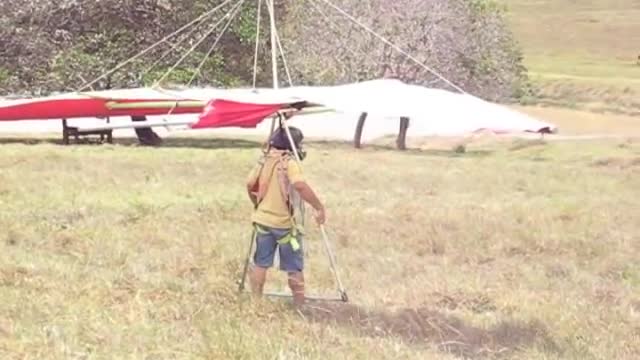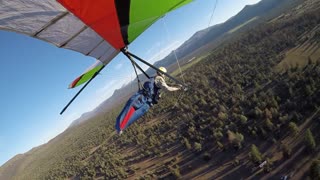Premium Only Content

Hang gliding
Hang gliding is an air sport or recreational activity in which a pilot flies a light, non-motorised foot-launched heavier-than-air aircraft called a hang glider. Most modern hang gliders are made of an aluminium alloy or composite frame covered with synthetic sailcloth[1] to form a wing. Typically the pilot is in a harness suspended from the airframe, and controls the aircraft by shifting body weight in opposition to a control frame.
Early hang gliders had a low lift-to-drag ratio, so pilots were restricted to gliding down small hills. By the 1980s this ratio significantly improved, and since then pilots can soar for hours, gain thousands of feet of altitude in thermal updrafts, perform aerobatics, and glide cross-country for hundreds of kilometers. The national airspace governing organisations control some regulatory aspects of hang gliding. Obtaining the safety benefits of being instructed is highly recommended.
Hang Gliding is air sport in which a pilot flies a light and non-motorized foot-launched aircraft called a hang glider. Most modern hang gliders are made of an aluminum or composite-framed fabric wing.Pilot usually control the aircraft by shifting body weight. The pilot wears a harness and is hung beneath a lifting wing by flexible straps.
Modern hang gliding emerged toward the end of the 1960s. In the early 1960s enthusiasts in California were gliding down coastal dunes on homebuilt delta-shaped wings they had adapted from kite designs developed by Francis Rogallo and his wife, Gertrude. The Rogallos’ kites had attracted attention because of interest in using them for spacecraft retrieval. On the dunes cheap materials such as bamboo and plastic sheeting were used, and the parallel-bar control method remained. Around the same time, water-ski showmen in Australia were flying on flat kites towed behind speedboats. They were able to control these notoriously unstable flat kites by using swing seats that allowed their entire body weight to effect pitch and roll—a great improvement on the parallel-bar method. When a Rogallo wing was fitted with a swing seat by John Dickenson, in Sydney, Australia, the modern hang glider was born.
Like all other engineless aircraft, hang gliders use gravity as the source of propulsion, so they are always sinking downward, just as a skier goes downhill. However, by seeking air that is moving upward faster than the aircraft is sinking, skilled pilots can remain aloft for hours. Typical sources for such lift occur where wind is deflected upward by a hill or mountain ridge or in columns of warm air called “thermals,” which are caused by the sun heating the Earth’s surface unevenly. Such is the efficiency of modern hang gliders that by 1999 the world straight distance record was 308 miles (495 km). Hang gliders are highly maneuverable, and their safety record compares well with that of other aviation sports.
There are basically two types of sail materials used in hang glider sails: woven polyester fabrics, and composite laminated fabrics made of some combinations.
Woven polyester sailcloth is a very tight weave of small diameter polyester fibers that has been stabilized by the hot-press impregnation of a polyester resin. The resin impregnation is required to provide resistance to distortion and stretch. This resistance is important in maintaining the aerodynamic shape of the sail. Woven polyester provides the best combination of light weight and durability in a sail with the best overall handling qualities.
-
 5:20
5:20
Hopefulgeek
3 years agoADVENTUROUS HANG GLIDING OVER MOUNTAINS
47 -
 6:22
6:22
Pasquale2
3 years ago $0.05 earnedHat Creek Hang Gliding June 26, 2022
761 -
 1:56:56
1:56:56
MattMorseTV
3 hours ago $3.99 earned🔴Trump's MASSIVE Press Briefing UPDATE.🔴
9.82K27 -
 1:35:04
1:35:04
Right Side Broadcasting Network
2 hours agoLIVE: Make America Healthy Again Commission Meeting - 9/9/25
14.3K2 -
 1:57:40
1:57:40
The Charlie Kirk Show
4 hours agoWhere Do Rights Come From? + Lions and Scavengers + Midway Blitz | Shapiro, Yoo, McLaughlin | 9.9.25
43K15 -
 1:19:45
1:19:45
The White House
6 hours agoPress Secretary Karoline Leavitt Briefs Members of the Media, Sep. 9, 2025
26.4K18 -
 1:24:12
1:24:12
Mark Kaye
3 hours ago🔴 ICE Invades Chicago- Operation Midway Blitz
18.6K1 -
 LIVE
LIVE
Badlands Media
13 hours agoGeopolitics with Ghost Ep. 37- Sept. 9, 2025
970 watching -
 4:07
4:07
Michael Heaver
4 hours agoBattered Germany Quickly Erupting Into PANIC
11.2K6 -
 1:05:32
1:05:32
Timcast
4 hours agoNepal's Government COLLAPSES, Gen Z REVOLUTION Over Social Media Ban, 19 Dead
108K91